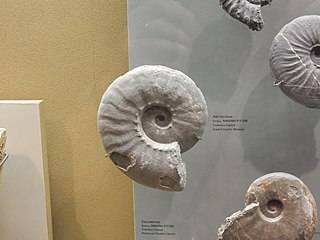
Xenodiscus is an extinct genus of ammonoid cephalopod and one of the earliest known ceratites, found in the Upper Permian of northern India and Timor. Xenodiscus is included in the family Xenodiscidae which is part of the ceratite superfamily Xenodiscaceae.
Albanites is a genus of extinct cephalopods belonging to the ammonoid order Ceratitida that lived during the Early Triassic epoch.
Ananorites is a genus of extinct cephalopods belonging to the ceratitd family Noritidae found in the Middle Triassic of the Himalaya. The shell is thinly discoidal, evolute, and smooth; cross section highly compressed; venter narrowly rounded except at the late stage where sharp shoulders are developed.
Arthaberites is a genus of ceratitid cephalopods included in the Noritidae that lived during the Middle Triassic, found in the Alps and Balkans of Europe. Its type is A. alexandrae.
Anotoceras is a genus of smooth shelled, discoidal ammonites with a depressed, subtrigonal whorl section and ceratitic sutures included in the ceratitid family Otoceratidae.

Arctoceras is a genus of ceratitid ammonoids from the Lower Triassic with a moderately narrow discoidal shell and ceratitic suture.
Arctomeekoceras is a genus of ammonoids in the order Ceratitida from the Early Triassic, included in the Meekoceratidae; a family characterized by more of less involute, compressed, discoidal forms that are smooth or weakly ornamented and have a ceratitic suture with broad saddles.
Badiotites is a genus of extinct ammonoid cephalopods belonging to the ceratitid family Badiotitidae. It was previously included with Lecanites in the Lecanitidae, a family formerly of the Clydonitaceae but reassigned by Tozer (1981) to the Danubitaceae. The Badiotitidae is included in the Ceratitaceae.
Ussuria is a genus of Lower Triassic ammonites with a smooth, involute discoidal shell with submonophyllic sutures, belonging to the ceratitid family Ussuriidae.

Ceratitida is an order that contains almost all ammonoid cephalopod genera from the Triassic as well as ancestral forms from the Upper Permian, the exception being the phylloceratids which gave rise to the great diversity of post-Triassic ammonites.
Noritoidea, formerly Noritaceae, is an extinct superfamily of cephalopods belonging to the Ammonite order Ceratitida.
Ussurites is an extinct ammonoid cephalopod genus belonging to the suborder Phylloceratina and is included in the family Ussuritidae. Its range is restricted to the early Middle Triassic, (Anisian)

Macrocephalites is a genus of the stephanoceratoid ammonite family Macrocephalitidae, diagnostic of the Callovian stage of the Middle Jurassic. Three subgenera, Dolikephalites, Kamptokephalites, and Pleurocephalites are recognized in addition to Macrocephalites itself, with Indocephalites tentatively included as the fourth.

Gymnitidae is a family of Lower to Middle Triassic ammonite cephalopods with evolute, discoidal shells.
Inyoites is an ammonoid genus from the Lower Triassic, included in the ceratitid family Inyoitidae.
Dagnoceras is a ceratitid ammonite from the Lower Triassic that has a basically evolutute, discoidal shell with an arched venter and ceratitic sutures. The Treatise 1957 includes it in the Meekoceratidae although it has since been placed in the Dinaritidae.
Dieneria is a genus of ceratitid ammonoid cephalopods from the Late Triassic of western North America with a smooth discoidal shall of which the venter is truncate and the suture simple. Only the first lateral lobe is slightly serrated, the other lobes entire (smooth)

Ophiceras is an extinct genus of smooth, evolute ceratitid ammonites from the Griesbachian, with a rounded venter. Fossils of the genus have been found in Armenia, Azerbaijan, China, Greenland, and India.
Clypeoceras is a genus of ammonites with an involute discoidal shell from the Lower Triassic.
Eophyllites is a genus of ammonoid cephalopods from the Lower Triassic and a predecessor of genera like Monophyllites and Ussurites.






